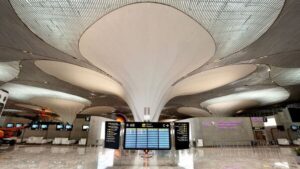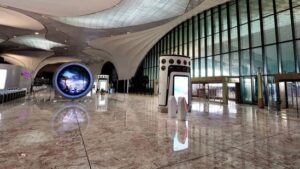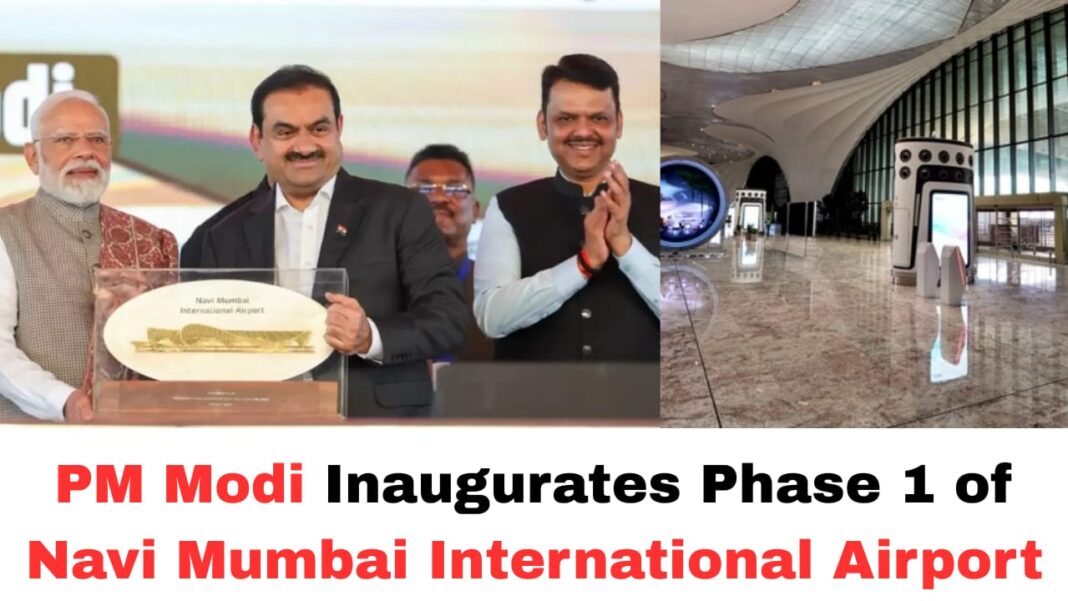Digital News Guru Maharashtra Desk:
Navi Mumbai International Airport Phase 1 Inaugurated by PM Modi
On October 8, 2025, PM Narendra Modi formally inaugurated Phase 1 of the Navi Mumbai International Airport (NMIA), a long-cherished infrastructure project that aims to transform Mumbai’s air connectivity and relieve the congestion on its existing airport.
This inauguration marks a milestone for India’s aviation sector, especially for the Mumbai Metropolitan Region (MMR). The development combines lofty ambitions — both in scale and design — with the practical need to ease capacity constraints and provide a modern, future-ready gateway.
Vision & Structure
NMIA is being developed as a greenfield airport under a public-private partnership (PPP) model, with Adani Airports Holdings Ltd holding a 74 % stake and CIDCO (City and Industrial Development Corporation of Maharashtra) retaining 26 %. The total cost for Phase 1 is about Rs 19,650 crore.

Phase 1 covers a land parcel of 1,160 hectares and includes Terminal 1 and a single runway capable of handling wide-body aircraft. Under this phase, the airport is designed to handle 20 million passengers annually and about 0.8 million metric tonnes of cargo.
Long term, NMIA is designed to scale up significantly. Once all phases are complete, it is projected to serve up to 90 million passengers per year and 3.25 million tonnes of cargo.
Architecturally, the terminal’s design draws inspiration from the lotus flower, with sculptural petal-like columns and large spans to create dramatic open spaces. The plan also emphasizes digital and automated systems — it is touted to be India’s first “fully digital” airport with online baggage drop, automated immigration and boarding, AI-based systems, and other smart features.
In keeping with sustainability goals, the airport will host solar power generation (47 MW), a dedicated Sustainable Aviation Fuel (SAF) storage facility, electric buses, and plans for water taxi connectivity to integrate with maritime transport.
Operational Timeline & Connectivity
Although the inauguration is complete, commercial flight operations will begin later. The expectation is that operations start in December 2025 after regulatory, safety, infrastructure, and systems readiness are validated. Both domestic and international flights are planned to operate from day one of opening.
To integrate NMIA with the broader transport network, multiple connectivity modes are planned:
- The Ulwe Coastal Road (UCR) and Kharghar Coastal Road (KCR) will provide road linkages.
- Rail connections will link via the Targhar railway station.
- Metro lines — particularly Navi Mumbai Metro Line 1 and proposed Mumbai Metro Line 8 (Gold Line) — are slated to integrate with the airport.
- There is a conceptual plan for waterway (water taxi) connectivity, making NMIA the first in India to leverage this mode.
These multimodal connections are intended to help the airport serve as a hub not just for air travel but for seamless intermodal transfers in the region.
Strategic & Economic Significance
Relieving Pressure on Mumbai Airport
Chhatrapati Shivaji Maharaj International Airport (CSMIA) has long been under strain with limited expansion options in an urban core. NMIA will act as a second international airport for Mumbai, giving Mumbai the rare distinction in India of having two international airports operating simultaneously.

Many business jets, turboprops, and charter aircraft currently using CSMIA are expected to be shifted to NMIA’s general aviation (GA) facilities by end of 2025, thereby freeing up capacity at CSMIA.
Also, plans to rebuild or reconfigure Terminal 1 at CSMIA are being linked to how and when NMIA expands full operations.
Gateway to Trade, Tourism, and Global Links
NMIA is being pitched not only as a passenger hub but as a major cargo and logistics node. With its large cargo handling capacity and proximity to ports, it has the potential to enhance trade routes into Europe, the Middle East, and beyond.
During his address, PM Modi underscored that farmers in Maharashtra will benefit, being better connected to international markets
With NMIA, Mumbai’s positioning as a global aviation hub is reinforced. Observers suggest the airport is being built to compete with major global airports — for instance, with aspirations to rival Heathrow or Incheon.
Political and Corporate Context
The inauguration also draws attention to the role of the Adani Group in India’s infrastructure development. The airport is one of Adani’s marquee projects following intense scrutiny and allegations over its business practices. Some view this move as a symbolic rehabilitation of the group’s image in public infrastructure.
Critics raise concerns about the close alignment of big infrastructure projects and political priorities. But supporters argue that such partnerships are necessary for large-scale modern infrastructure, given government budget constraints.
Challenges & Risks
While the inauguration is celebrated with fanfare, NMIA’s journey ahead is not without challenges:
Safety & Environmental Concerns
One pressing issue is air safety, especially the risk of bird strikes due to slaughterhouses and garbage disposal within 3 km of the runway — violations of DGCA-mandated buffer zones. Activist organizations and watchdogs have flagged that makeshift meat shops and waste dumps resumed operations in proximity to the airport, jeopardizing the aerodrome’s safety profile.
In response, the DGCA has initiated monthly inspections, formed a sub-committee under the Aerodrome Environment Management Committee, and started a year-long Wildlife Hazard Assessment survey.
Synchronizing Connectivity & External Infrastructure
While the airport infrastructure is ready, external connectivity projects — roads, metro lines, coastal roads — must keep pace. Any lag or mismatch could bottleneck passenger flows and dampen the airport’s utility.
The Ulwe Coastal Road and Kharghar Coastal Road are critical links currently under progress; delays here may hamper access.
Another factor is the coordination between airport operations and air traffic management, regulatory clearances, and ensuring all safety systems are fully tested before commercial operations commence.

Market & Operational Risks
Launching a major new airport involves demand risk: whether airlines will commit early, whether passenger volumes justify the scale, and how the airport performs in its early years. Also, migrating existing traffic from CSMIA to NMIA without disruption is operationally complex.
Further, given the massive capital investment, return on investment depends on sustained utilization and cargo throughput.
Outlook & Expectations
If successful, NMIA could redefine Mumbai’s aviation landscape. The region can expect:
- Reduced congestion and improved passenger experience at Mumbai’s airports
- Boosts to regional economy, tourism, and connectivity
- A more balanced air network across India, with Mumbai becoming a multi-airport hub
- Modern benchmark for airport design, sustainability, and digital integration
However, much will depend on careful execution — completion of supporting infrastructure, strict adherence to safety norms, effective demand generation, and seamless operational transition.
In the coming months, eyes will be on how airlines roll out schedules, how portal booking systems switch to the new airport code (NMI), how ground transport integrates, and how smoothly the first flights land and take off from this new facility.
With this inauguration, India reaffirms its commitment to upgrading infrastructure to match its economic ambitions. But the real test lies in successful, sustained operations.
You May Also Read: Karnataka Closes Schools Oct 8–18 So Teachers Can Complete Caste Survey








